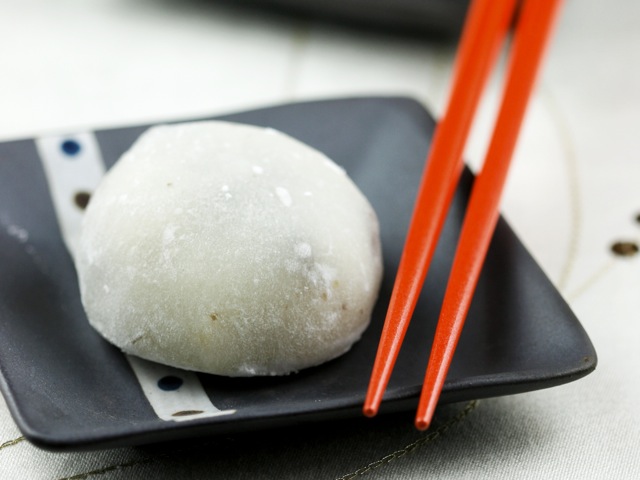
reference-image, l
(article, Anita Chu)
[%pageBreakSettings nobreak=true] In Western culture, rice is a simple side dish. But in Japan, it's prepared in dozens of forms that often look nothing like grains of rice. Take mochi, for example. A glutinous rice cake with a bland, chewy texture, mochi is traditionally made in Japan at parties welcoming the New Year. [[block(sidebar). h1.Featured recipe]] The classic mochi-making process is called mochitsuki, and involves soaking cooked glutinous rice overnight, then pounding it with wooden mallets on a stone mortar. At New Year festivities, celebrants take turns pounding the rice, then forming the resulting soft, sticky dough into balls and cakes. The entire process is a way of honoring the rice, of purifying its essence. In the West, mochi is most commonly available as a confection, a squishy, marshmallow-like treat to be popped in the mouth as is. But mochi can be also be served in dessert soups, like sweet meatballs, or cooked and eaten as a savory dish. Mochi has origins in the cooked rice cakes of China; mentions of mochi are found as early as the eighth century in Japanese literature. Originally made only for special religious occasions and consumed by the upper classes, mochi slowly filtered down to the common people, who loved this portable, easy-to-eat treat. The origin of the word mochi is uncertain, although mochizuki means “full moon,” which is perfectly apropos since the Japanese see not a man-in-the-moon in the night sky, but a rabbit tirelessly pounding rice on his mortar. [%image reference-image float=right width=400 caption="A mochi dumpling."] Mochi is just one kind of wagashi, the Japanese term for beautifully crafted traditional sweets served with tea. Most of the more elaborate forms of wagashi are made by professional confectioners, often at centuries-old outfits practicing ancient methods handed down through generations. The skill required to create wagashi means that making them isn't generally attempted at home. But mochi is one happy exception. One of the most common forms of sweet mochi is daifuku mochi, a simple ball of mochi dough enclosing a filling. The classic filling is anko, a sweet, creamy paste made from adzuki beans, but many modern mochi fillings can also be found, from fruit to ice cream. The fillings vary to reflect the seasons; for example, sakura mochi (mochi scented with cherry blossoms) appear at the beginning of the cherry-blossom season in spring. Another popular version, ichigo daifuku, has a whole fresh strawberry tucked inside the mochi wrapper. For those lacking either a mortar and mallet or a modern mochi-making machine, there's a fast and relatively labor-free method for making your own mochi at home: glutinous rice flour and the microwave. By using glutinous rice flour, you can bypass the rice-pounding process entirely. When combined with water, the flour becomes a soft, sticky dough that can be molded into balls of mochi. The dough may seem intimidatingly sticky, which is where starch (potato, corn, or tapioca) comes in. Don’t be afraid to dust the dough and the work surface liberally with the starch. Once the dough is ready, you can simply pinch off pieces and flatten them into circles to wrap around nuggets of filling. But you can ensure consistency and fineness by rolling out the dough and cutting it into rounds. Probably the best-known mochi dessert in the West is the version filled with ice cream. It's easy enough to make at home, so long as you've formed all the mochi dough circles ahead of time. Scoop a small ball of slightly softened ice cream into the center of each circle, then wrap the dough around the ice cream. Place the formed mochi dumplings into the freezer for a couple of hours to firm up, then remove a few minutes before serving to soften again slightly. Serve this round, frosty dessert to your New Year's guests, and tell them that the moon-shaped dumplings were made by the rabbit in the night sky. p(bio). Anita Chu keeps a blog called Dessert First. She's also the author of the dessert books Field Guide to Cookies and Field Guide to Candy.

reference-image, l